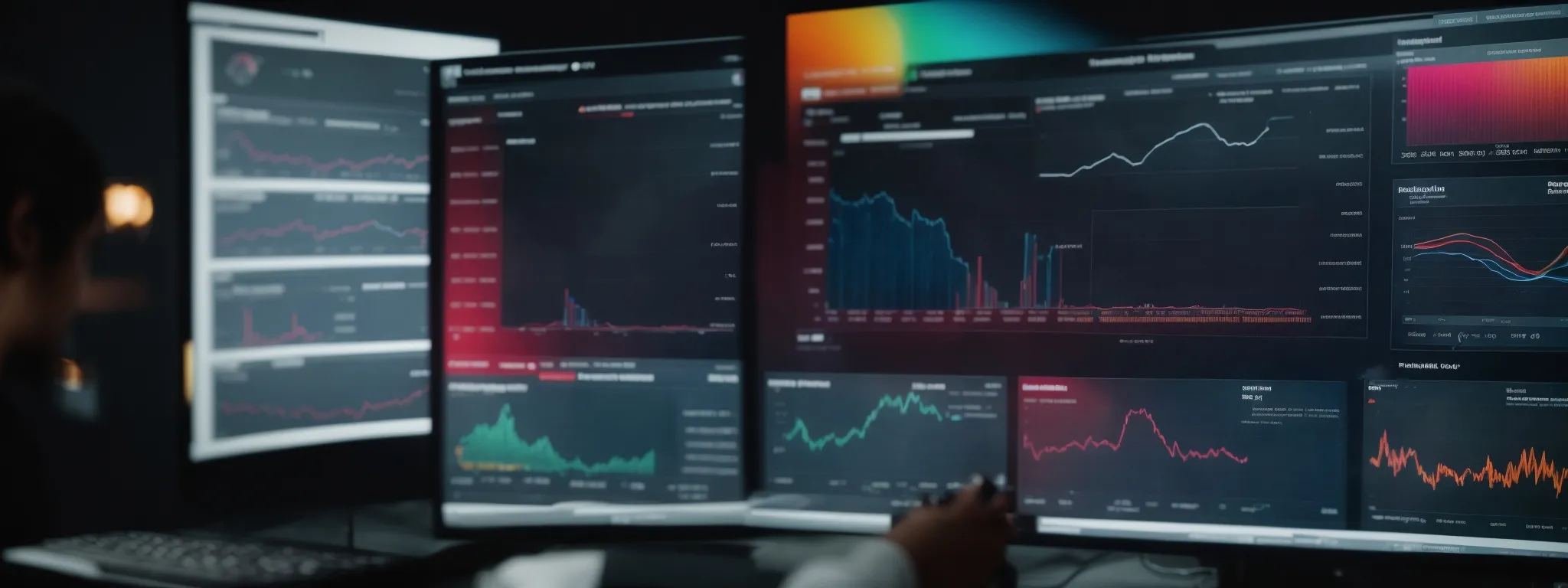Optimize and Convert: Essential Conversion Rate Optimization Tools
Maximize Your Website’s Performance: Essential Conversion Rate Optimization Tools In today’s digital landscape, the difference between a thriving online business and one that merely survives can often […]
Maximize Your Website’s Performance: Essential Conversion Rate Optimization Tools
In today’s digital landscape, the difference between a thriving online business and one that merely survives can often be attributed to how effectively it optimizes for conversions.
Conversion Rate Optimization (CRO) tools are indispensable assets for marketers seeking to transform passive website visitors into active users, effectively influencing the bottom line.
From insightful analytics to nuanced user behavior analytics, these platforms offer a multitude of features tailored to enhance the user experience and maximize conversion potential.
By leveraging the right CRO tools, businesses gain the ability to scrutinize data, hypothesize improvements, and test strategies for optimal results.
Keep reading to explore the transformative capabilities of the top CRO tools in the industry.
Key Takeaways
- Conversion Rate Optimization Tools Offer Detailed Insights Into User Behavior to Optimize Website Performance
- Effective CRO Involves Utilizing Predictive Analytics and AI to Anticipate and Influence User Behavior
- Mobile Optimization Is Essential for CRO, Highlighting the Need for Responsive Design and Mobile-Friendly User Interfaces
- Integrating Social Proof Through Reviews, Testimonials, and Third-Party Validation Enhances Trust and Conversion Rates
- Continuous a/B Testing, Guided by Key Metrics, Is Crucial for Iterative Website Improvement and Conversion Growth
Discover the Must-Have Conversion Rate Optimization Tools

In the dynamic realm of digital marketing, Conversion Rate Optimization (CRO) stands as a pivotal component for enhancing a website’s efficacy.
Precise tools designed for CRO can foster an environment where user engagement transforms seamlessly into tangible conversions, galvanizing business growth.
These tools serve not only to elucidate user behavior but also to bolster the execution of strategies tailored to meet specific website objectives.
As businesses explore an array of cutting-edge utilities, understanding which tools magnify their unique website goals emerges as paramount.
Such precision in tool selection and integration into conversion strategies paves the way for a robust framework to quantify success and refine approaches to reap the highest returns.
A comprehensive exploration into CRO tools’ influence on performance is the first stride towards crafting a user experience that is both gratifying and profitable.
Understanding CRO Tools and Their Impact on Performance
Conversion rate optimization tools are instrumental in diagnosing the precise elements of a website that engage visitors and incite action. They leverage data science and user experience (UX) principles to underscore parts of the digital journey that can be optimized for increased interaction and elevated conversion rates.
Through the use of Behavior Analytics Tools such as heat maps and session replays, these tools provide actionable insights, allowing businesses to make informed decisions. They pinpoint user struggles and successes, guiding web designers and marketers to fine-tune interfaces, streamline workflows, and eliminate barriers that might impede conversion growth.
Evaluating the Best Tools Suited for Your Website Goals
Selecting the right tools for enhancing a website’s conversion rates is a nuanced process, one that requires a keen understanding of one’s unique digital landscape. Marketers and webmasters must align the functionalities of various CRO technologies with their strategic goals, ensuring each tool contributes to a seamless user journey and eliminates conversion obstacles.
From behavior analytics to A/B testing platforms, each CRO tool unveils different facets of user interaction and satisfaction; discerning which tool or suite of tools will drive the desired outcomes necessitates a meticulous assessment of their performance benefits:
| Tool Category | Core Function | Website Objective |
|---|---|---|
| Behavior Analytics | Monitor user activity and highlight usability issues. | Improve user engagement and website usability. |
| A/B Testing | Compare different versions of a web page to determine the most effective one. | Optimize page elements for increased conversions. |
| Customer Feedback | Gather direct input from users regarding their experience. | Refine content and functionality to meet user needs. |
Integrating Tools That Align With Your Conversion Strategy
Integrating conversion rate optimization tools demands a strategic approach that is harmonious with company-specific conversion goals. It’s about choosing tools that do not just collect data, but also facilitate actionable insights aligned with the laid-out conversion strategies.
Success hinges on the seamless incorporation of these tools into the digital marketing workflow, ensuring continuous learning and improvement in the conversion optimization journey. The right mix of tools empowers businesses to iterate and enhance every touchpoint along the customer journey:
- Evaluating the collision of user interface decisions on user behavior and subsequent conversion rates.
- Adjusting content and design elements in response to real-time user feedback and testing outcomes.
- Harmonizing analytics insights with marketing strategies to optimize the user’s path to conversion.
It is through this meticulous tool integration that businesses can fully harness the potential of their analytics, fostering a culture of data-driven decision-making that elevates the customer experience and amplifies conversion success.
Measuring Success and Adjusting Tools for Maximum Gain
Assessing the efficacy of Conversion Rate Optimization (CRO) tools is critical, as it anchors the ongoing process of fine-tuning a website to achieve superior results. Businesses must establish clear metrics to evaluate the success of their CRO efforts, ensuring they reflect the evolving needs and behaviors of their target audience.
Upon analysis of performance data, it is paramount for companies to remain agile, ready to recalibrate their CRO toolbox. This adaptability allows for the refinement of strategies and ensures that the tools employed are congruent with the primary objective of maximizing conversions and website performance.
Key Features to Look for in CRO Platforms

As businesses delve into the realm of Conversion Rate Optimization (CRO), discerning the vital features within CRO platforms becomes critical to elevate website performance.
Paramount to this pursuit are A/B testing functionalities, which provide data-driven insights to optimize page elements, and the integration of user experience as a cornerstone in tool selection.
Equipped with robust analytics and reporting capabilities, these platforms offer a clear view into the user journey, allowing for strategic adjustments and improved outcomes.
Furthermore, customization options stand as a linchpin, empowering brands to tailor the digital experience and facilitate a personal connection with their audience.
These pillars of CRO platforms collectively underpin a formidable strategy, aimed at converting casual browsers into loyal customers.
Importance of a/B Testing Functionalities
The importance of A/B testing functionalities within Conversion Rate Optimization platforms cannot be overstated. These features allow businesses to experiment with different versions of a web page or element, empowering them to make data-informed decisions that could significantly improve their conversion rates.
By implementing A/B testing, companies are granted the ability to discern the layouts, headlines, or images that resonate most with their target audience. This methodical testing can lead to enhanced user experience and a demonstrable uplift in website performance, directly impacting a business’s bottom line.
The Role of User Experience in CRO Tool Selection
In the crucible of CRO tool selection, user experience (UX) acts as the compass that guides enterprises toward success. Platforms that prioritize UX ensure that visitors encounter a frictionless and engaging digital environment, paving the way for higher conversion rates.
Selecting CRO tools that amalgamate insightful analytics with an intuitive user interface promotes an optimization process that is both effective and user-centered: Any chosen tool should not only afford ease of use for the marketing team but also enhance the end user’s journey through the website.
- Consideration of UX design principles in tool interfaces to facilitate efficient use by the marketing team.
- Integration of user feedback mechanisms into the platform to capture and respond to audience needs.
- Deployment of behavioral analytics to isolate and remedy user experience hiccups.
Analytics and Reporting Capabilities You Need
Analytics and Reporting capabilities are vital organs in the anatomy of CRO platforms, as they furnish businesses with the raw data and interpretive power to gauge website performance accurately. These features grant a lens into the efficacy of various website components, offering a granular view into user interactions, behavior patterns, and conversion bottlenecks.
An exemplary CRO tool should proffer not just data collection but also detailed reporting functionalities that translate complex data sets into comprehensible, actionable insights. This empowers companies to respond swiftly to analytics, finetuning strategies to optimize user experience, and effectively bolster conversion rates.
Customization Options to Personalize the Customer Journey
Within the arsenal of Conversion Rate Optimization tools, customization options emerge as the backbone of personalizing the customer journey. These flexible features allow businesses to tailor the online experience, catering specifically to individual preferences and historical interactions with the website.
The agility to design a unique path for each visitor—not only boosts engagement but can also significantly lift conversion rates. Providing a bespoke experience underscores a brand’s commitment to understanding and meeting customer needs:
| Customization Feature | Benefit | Impact on Customer Journey |
|---|---|---|
| Dynamic Content Display | Personalizes content based on user behavior. | Enhances relevance and resonates with user needs. |
| User-specific Recommendations | Leverages past interactions to suggest relevant products/services. | Streamlines discovery, increasing the likelihood of conversion. |
| Custom Landing Pages | Aligns marketing campaigns with tailored landing page experiences. | Creates a cohesive journey from advertisement to conversion. |
By embedding customization throughout the customer’s digital adventure, organizations enact a powerful form of direct marketing. It’s this precise element that converts routine transactions into memorable experiences, prompting not only conversions but also engendering loyalty.
Unlocking the Power of Analytics for Website Optimization

In an era where online presence is synonymous with business success, leveraging the right analytics tools for website optimization is a non-negotiable imperative.
A firm grasp of pertinent data lays the groundwork for understanding and enhancing the user’s journey from that first click to the final conversion.
By harnessing the robust capabilities of Google Analytics, comprehensive heatmaps, and session recordings, businesses gain an unprecedented window into the behavior and preferences of their audience.
This incisive application of user behavior data not only clears the path to an optimized conversion route but also helps pinpoint any underlying issues thwarting effective funnel performance.
It’s within this analytical prowess that the potential for elevated website efficacy and improved user engagement lies.
Harnessing Google Analytics for Deeper Insights
Google Analytics emerges as an indispensable asset for webmasters seeking granular insights into site performance. By tapping into this analytic powerhouse, businesses can dissect streams of data, gaining clarity on user behavior patterns, traffic sources, and content efficacy.
With a focus on active users, conversion rates, and session duration metrics, Google Analytics equips organizations with the means to make informed decisions. These insights serve as the linchpin for optimizing the website’s layout, content, and navigation to bolster user engagement and enhance conversion potential.
Advanced Tracking With Heatmaps and Session Recordings
Advanced Tracking Through Heatmaps offers an intuitive visualization of how users interact with a website, highlighting areas of high engagement and potential points of friction. These graphical representations of user activity can elucidate patterns, such as mouse movement and clicks, enabling optimizers to make data-driven improvements to the website’s design and functionality.
Session recordings stand as a complement to heatmaps, providing a replay of user browsing sessions to capture the nuances of the user experience. This enables businesses to observe firsthand how visitors navigate their site, identifying obstacles or distractions that may impede the conversion process and allowing for precise refinements to enhance the overall user journey.
Leveraging User Behavior Data to Improve Conversion Paths
Leveraging User Behavior Data is pivotal in crafting a seamless conversion path that aligns with the nuances of customer interactions. By analyzing actions such as pageviews, time spent on the site, and navigation patterns, businesses can pinpoint areas where the user’s journey can be optimized to facilitate a smoother transition from prospect to customer.
This data-driven approach enables the continuous refinement of conversion-related elements, ensuring that every facet of the website is geared towards converting browsers into buyers. These informed modifications elevate the user experience, undergirding the site’s architecture with the solid bedrock of empirical evidence:
- Analyzing the flow of user engagement to identify trends and drop-off points within the site.
- Executing structured A/B testing to iterate and validate the impact of changes on conversion rates.
- Revising call-to-action placements and messaging based on user feedback and engagement metrics.
Analyzing Funnel Performance and Identifying Bottlenecks
Analyzing the performance of conversion funnels is a critical exercise in pinpointing the stages where potential customers disengage. By thoroughly examining each step, companies can identify specific bottlenecks: points at which visitors hesitate, falter, or abandon their journey towards making a purchase or completing a desired action. This analysis is the first step in unraveling the complexities that hinder conversion rate optimization.
- Mapping out the customer’s path from initial interest to the final conversion outcome.
- Evaluating the friction points that cause attrition and reduce conversion momentum.
Once bottlenecks are detected, businesses are empowered to implement targeted solutions, aiming to streamline the conversion process. Strategic enhancements such as simplifying form fields, clarifying navigation cues, or optimizing page loading times can dramatically reduce friction, thereby bolstering the rate of successful conversions and maximizing website performance.
Enhance User Experience With Qualitative CRO Tools

In the pursuit of optimizing a website’s performance, the constellation of Conversion Rate Optimization (CRO) tools shines a light on the essence of user experience.
Qualitative CRO tools unlock the door to a deeper comprehension of visitor interactions and sentiments, providing a nuanced view that goes beyond mere numbers.
By implementing on-site surveys and feedback forms, conducting usability testing, and actively collecting visitor data, businesses gain insightful perspectives on visitor needs and expectations.
This rich qualitative data forms the bedrock for informed decision-making, directly influencing user satisfaction and ultimately steering the website towards peak performance.
Implementing on-Site Surveys and Feedback Forms
On-site surveys and feedback forms stand as pivotal channels for acquiring valuable insights directly from users. By integrating these tools, businesses capture the voice of the customer, revealing underlying motives, pain points, and desires that influence their interaction with the website.
The implementation of these feedback mechanisms into the website’s interface facilitates an open dialogue with users, fostering an environment of continuous improvement. Valuable user-generated data from these interactions informs strategic decisions on content, design, and functionality enhancements:
- Identify areas of user frustration that may hinder conversion.
- Gauge the effectiveness of recent website changes.
- Elicit user suggestions for new features or content.
Employing Usability Testing to Refine User Interfaces
Usability testing stands as a cornerstone in refining user interfaces, wherein real users interact with a website, providing insights on navigation, layout, and overall user experience. This iterative process allows design and development teams to identify and remedy usability obstacles, thus facilitating a smoother user journey.
Armed with the feedback gleaned from usability tests, organizations can implement strategic design changes that elevate the usefulness and intuitiveness of their digital assets. The direct correlation between a user-centric interface and increased conversion rates underscores the significance of continuous usability optimization.
- Catalog user interactions and feedback to highlight interface pain points.
- Iterate on design elements based on user test outcomes.
- Evaluate the efficacy of interface improvements in subsequent usability trials.
Gathering Qualitative Data to Understand Visitor Needs
Gathering qualitative data is a strategic endeavor, presenting businesses with the context-rich insights that quantitative data alone cannot offer. It allows an organization to decipher the nuanced preferences and behaviors of visitors, bridging the gap between numerical data and human experience.
Through qualitative research methods such as in-depth interviews, focus groups, and direct observations, companies can construct a more accurate profile of their visitor base. This deepened understanding lays the foundation for website enhancements that cater precisely to user needs and foster a more intuitive and satisfying user experience.
Making Data-Driven Decisions to Enhance User Satisfaction
Data-driven decision-making in Conversion Rate Optimization (CRO) allows for a keen calibration of user experiences that align with customer expectations and satisfaction. By meticulously analyzing user behavior analytics, companies can substantiate which website adjustments will have the most significant impact on their audience engagement and conversion metrics.
Companies employing this methodical approach refine their websites with precision, ensuring that every modification is grounded in empirical evidence collected from their target demographic. This strategy not only streamlines the user journey but also elevates the overall satisfaction by creating an intuitive and responsive digital environment that resonates with the end-user’s needs.
Using a/B Testing Tools to Drive Conversion Growth

Embarking on a comprehensive a/B testing regime is pivotal for businesses eager to optimize their website’s conversion rates and bolster user experience.
These empirically-driven experiments are the backbone of an effective conversion rate optimization strategy, enabling teams to systematically explore variations in webpage design, content, and functionality.
This approach to testing provides a platform to ascertain which elements resonate most effectively with the audience, facilitating iterative refinements that culminate in measurable performance improvements.
Furthermore, establishing best practices for conducting ongoing a/B tests ensures that websites remain dynamically aligned with user preferences and market trends, consistently fostering conversion growth.
Setting Up Effective a/B Tests With the Right Tools
Identifying the appropriate tools for a/B testing is a critical step in the quest for conversion growth, requiring a choice that complements both the technological infrastructure and the strategic aims of a website. The ideal a/B testing tool facilitates ease of setup for experiments, precise segmentation of the audience, and reliable collection of data to yield actionable insights, all while ensuring minimal disruption to the user experience.
Market leaders recognize the importance of integrating a/B testing tools that deliver real-time analytics and rapid test iteration. They invest in solutions that not only streamline the creation of test variants but also enhance the agility of their marketing teams to respond to data trends and apply optimization tactics that refine the user journey towards conversion success.
Understanding Key Metrics for a/B Test Analysis
Grasping the nuances of key metrics is essential when analyzing the success of A/B tests. Metrics such as conversion rate, bounce rate, average time on page, and click-through rate provide definitive insights into user behavior and preferences, guiding marketers to make data-backed decisions that bolster the website’s effectiveness.
Integral to the analytical process is the accurate interpretation of these metrics, which sheds light on the user’s interaction with test variations. Meticulous analysis aids in distinguishing winning strategies from less impactful changes, empowering businesses to refine their websites with a precise understanding of what drives user conversions.
Iterating on Test Results to Constantly Improve Outcomes
Establishing a loop of iteration based on A/B test results is vital for sustaining website improvement and conversion growth. By analyzing the outcomes of each test iteration, businesses can continuously refine their digital strategies and enhance the elements that drive user engagement and boost conversions.
The process of iterating on A/B test results hinges on the responsive adjustment of website features. Armed with empirical insights, companies can evolve and finesse their online presence, ensuring that every change is a step towards an optimized user experience and increased conversion efficacy.
Best Practices for Ongoing a/B Testing Strategies
Embracing the best practices for ongoing a/B testing is central to maintaining conversion momentum and reinforcing a user-focused website design. It is about creating a culture within the organization where data-driven experimentation is welcomed and where learnings from each test cycle feed into the next, fostering a philosophy of continuous improvement.
Clear methodologies should guide the a/B testing process, ensuring consistency and reliability in how tests are conducted and results are measured. This disciplined approach enables the organization to accurately gauge the impact of modifications and steer the website toward optimal user engagement and conversion performance:
- Develop a structured testing plan with clear objectives and hypotheses for each experiment.
- Utilize segmentation to target specific user groups, ensuring relevant data and insights.
- Maintain rigorous documentation for every test to capture variations, goals, and outcomes.
- Communicate results across teams to facilitate learning and encourage collective ownership of the website’s success.
- Apply incremental changes based on the insights derived, refining the website iteratively and intelligently.
To propel a website’s performance to new heights, companies need to internalize these testing strategies as an integral part of their digital marketing efforts. These practices are not simply tasks on a checklist but are strategic, insightful actions that contribute to a well-honed conversion rate optimization engine.
Personalize User Interactions With AI-Driven CRO Tools

In the pursuit of optimizing website performance, integrating Artificial Intelligence (AI) into Conversion Rate Optimization (CRO) tools provides a powerful means to tailor user experiences uniquely.
AI’s capabilities enable websites not just to respond to user behavior but to anticipate it, offering personalized interactions that are crucial for boosting engagement and conversions.
The adoption of machine learning techniques allows for the continual analysis and optimization of myriad website variables, refining user experiences in real time.
By leveraging predictive analytics, businesses can stay one step ahead, adapting to emerging user trends and needs with precision.
This strategic use of AI-driven CRO tools transforms how websites interact with visitors, paving the path to superior conversion growth and enhanced competitive advantage.
Benefits of Using AI for Personalized Website Experiences
In the realm of Conversion Rate Optimization, AI ushers in a nuanced approach to understanding and engaging with website users. By analyzing behavioral patterns, AI-driven tools can proactively offer tailored recommendations and content adaptation, subsequently fostering an environment where each visitor’s experience is as unique as their digital footprint.
This personalized touch, powered by AI, does more than just resonate with users; it effectively increases the likelihood of conversion by aligning offerings with individual preferences and behaviors. As a result, businesses benefit from elevated user satisfaction and loyalty, driving repeat interactions and positive word of mouth.
| Feature | Description | Impact |
|---|---|---|
| Behavioral Analysis | AI algorithms scrutinize user actions and engagement. | Facilitates content and recommendation personalization for each user. |
| Adaptive Content | Dynamic adjustment of web content in real-time based on user behavior. | Creates a tailored experience, potentially boosting conversion rates. |
| Increased Loyalty | Personalized experiences inspire repeated visits and customer advocacy. | Strengthens brand loyalty and encourages long-term consumer relationships. |
Using Machine Learning to Optimize Conversion Rates
Machine learning offers a transformative approach to Conversion Rate Optimization by dynamically analyzing and adjusting websites based on user activity. This advanced facet of AI technology empowers businesses to deliver an optimized user experience that evolves with consumer behavior and trends.
By actively learning from data patterns and outcomes, machine learning algorithms provide the foresight needed to make predictive adjustments. These enhancements are critical in streamlining the conversion process, leading to higher conversion rates and a compelling digital presence that adapts to user expectations in real-time.
Tools That Adapt in Real-Time to User Behavior
Tools that adapt in real-time to user behavior are increasingly becoming vital components in the CRO toolkit. They dynamically adjust website content and pathways, responding instantaneously to actions taken by users to create a fluid and responsive browsing experience that smooths the road to conversion.
These sophisticated tools employ advanced analytics to detect subtle changes in user behavior, enabling the website to present personalized content that aligns with individual user preferences and habits. The immediacy of the adaptation not only captivates the user but also enhances the likelihood of their transition from visitor to loyal customer.
Staying Ahead of the Curve With Predictive Analytics
Predictive analytics is rapidly defining the frontier of Conversion Rate Optimization (CRO), offering foresight into user behavior that revolutionizes the way businesses engage with their audience. By leveraging these advanced analytical capabilities, websites can preemptively adjust strategies, ensuring a responsiveness that keeps pace with evolving user expectations.
Incorporating predictive analytics into CRO tools empowers websites to not only react to current user interactions but also anticipate future needs, leading to a more refined and proactive user experience. The infusion of this technology translates into a competitive advantage, affording businesses the agility to stay at the vanguard of user engagement and conversion success.
Optimize for Mobile Users With Responsive Design Tools

In the digital age, where smartphones reign supreme, optimizing for mobile users has become a keystone in Conversion Rate Optimization (CRO).
Reflecting on the swelling ranks of mobile traffic, a website must showcase seamless mobile functionality to capture and retain a discerning audience.
Tailored tools are essential for ensuring that your site is not only mobile-friendly but also fine-tuned to the unique behavioral patterns of on-the-go users.
Crafting responsive Calls to Action (CTAs) and engaging user interfaces that perform on smaller screens is not merely adjunct; it is mandatory for a robust CRO strategy that targets a mobile-centric user base.
Importance of Mobile Optimization in CRO
The centrality of mobile optimization within Conversion Rate Optimization (CRO) strategies cannot be overstated. As mobile browsing continues to outpace desktop, businesses are compelled to deliver a mobile user experience that is not just functional, but exemplary, ensuring engagement and conversion opportunities are not squandered.
A website’s performance on mobile devices directly influences its ability to convert traffic into valuable actions. Recognizing and adapting to the needs of the mobile audience enhances the site’s accessibility, bolsters user retention, and provides a competitive edge in the fast-paced mobile market.
Tools to Ensure Your Website Is Mobile-Friendly
Ensuring a website’s mobile-friendliness hinges on leveraging responsive design tools that adapt content and layout to the myriad of screen sizes and devices in use today. These tools automatically rescale images, adjust grid layouts, and reconfigure navigation menus to deliver a consistent and intuitive user experience across all platforms, facilitating not just accessibility but also driving the potential for increased conversion rates.
Investing in mobile optimization tools is imperative for any business seeking to excel in the digital landscape, where mobile-first indexing by search engines underscores the significance of mobile user experience. Responsive design tools help guarantee that a website meets the stringent criteria of speed, legibility, and ease of use necessary to engage the modern user, substantially impacting a site’s visibility and user retention.
Analyzing Mobile User Behavior for Targeted Improvements
Analyzing mobile user behavior is an intricate element of Conversion Rate Optimization, as it allows businesses to discern the distinct interactions that mobile users have with their website. Gaining a thorough understanding of these behaviors through tools like mobile analytics platforms and user testing, organizations can pinpoint specific areas where the mobile experience can be optimized for increased engagement and conversion rates.
By evaluating metrics such as touchpoint effectiveness and navigation flow on mobile devices, businesses acquire the knowledge necessary to implement targeted improvements that enhance the mobile user experience. This can lead to a more intuitive and user-friendly mobile interface, a critical step towards maximizing conversions in an increasingly mobile-driven online marketplace.
Designing Responsive CTAs That Convert on Smaller Screens
Designing responsive calls to action (CTAs) that excel on smaller screens is pivotal for capturing the mobile audience’s fleeting attention span. A CTA must be visually prominent and textually compelling to prompt action, ensuring that the intricacies of navigating on handheld devices do not dilute its effectiveness.
To bolster conversion rates, CTAs on mobile websites must be thumb-friendly, meaning they should be easily clickable without causing user frustration. Ensuring that these critical conversion triggers are adaptable to varying screen sizes and orientations exemplifies a brand’s dedication to providing an exceptional mobile user experience.
Leverage Social Proof With Strategic CRO Techniques

The digital marketplace is an arena built on perception, where the impressions of others can significantly sway decision-making processes.
In this context, leveraging social proof becomes a strategic touchstone for effective Conversion Rate Optimization (CRO).
Intertwining user reviews and testimonials into a website can offer visitors a sense of security and trust, influencing their readiness to convert.
Tools that adeptly exhibit real-time user activity and third-party validation promote transparency and further bolster a site’s credibility.
Aspects such as verification badges and social signals serve not as mere design elements but as potent instruments that reinforce credibility and ensure a website’s offerings are perceived as trustworthy and reliable.
This integration of social proof into CRO strategies embodies a crucial endeavor for businesses aspiring to enhance their digital standing and drive conversion growth.
Incorporating User Reviews and Testimonials Effectively
Effective incorporation of user reviews and testimonials breathes life into a website’s social proof, showcasing real-world validation that resonates with prospective customers. By strategically placing these elements where they can have the most impact – such as near calls to action or featured products – businesses cement trust and lend weight to their offerings.
Highlighting testimonials from satisfied customers not only amplifies a product’s appeal but also subtly communicates the value proposition to potential buyers. It’s a practice that translates the satisfaction of past customers into a powerful influence on the purchasing decisions of future ones, thereby fueling conversion rate optimization efforts with authentic user experiences.
Tools for Showcasing Real-Time User Activity
Displaying real-time user activity on a website operates as a dynamic form of social proof, reinforcing the credibility of services and products. With these tools, visitors witness the flow of customer engagement through updates on recent purchases, sign-ups, or reviews, fostering an atmosphere of trust and bustling activity.
Strategically utilizing real-time user activity tools can highlight the community’s endorsement of a website’s offerings, subtly nudging new users toward conversion. This proven technique capitalizes on the fundamental human tendency to follow collective behavior, effectively boosting confidence in decision-making.
Boosting Trust With Third-Party Verification Badges
Integrating Third-Party Verification Badges is a strategic move that instills confidence in site visitors. These badges, often associated with security and authenticity, serve to reassure users that the website they are dealing with upholds stringent standards for safety and credibility.
Display of such marks of validation, from recognized authorities or industry leaders, can be the determining factor in converting a hesitant visitor into a confident customer. Trust signals like these can significantly de-risk transactions, thereby encouraging user action and bolstering the website’s conversion rates.
Using Social Signals to Reinforce Credibility
Employing social signals as a method to establish credibility taps into the collective endorsement of a brand by its audience on various social media platforms. These indicators, such as likes, shares, and followers, are visible markers of a community’s approval and can significantly influence the perception of new visitors to a website, enhancing trust in a subtle yet powerful way.
Businesses adept at weaving these indicators into their website’s narrative demonstrate a connectedness and reputation that resonates with users. The strategic use of social signals amplifies a sense of established presence and reliability, encouraging users to engage with the content, trust in the brand’s authority, and ultimately, make confident conversion decisions.
Conversion Funnel Optimization for Streamlined Journeys

In an increasingly competitive digital ecosystem, the effectiveness of a website’s conversion funnel is paramount to its success.
Attuned businesses recognize that a comprehensive conversion optimization strategy entails a deep dive into the intricacies of the conversion funnel – from the initial customer touchpoint to the ultimate conversion action.
By meticulously mapping out the entire funnel, employing sophisticated tools for visualization and optimization at each stage, and tackling any leaks that diminish conversion potential, companies can significantly elevate their website’s performance.
Adding a layer of automation and personalization harnesses technology’s prowess to refine the funnel experience further, making it a tailored and efficient journey for every user.
Mapping Out the Entire Conversion Funnel
Efficient Mapping of the Entire Conversion Funnel is a tactical necessity for businesses aiming to diagnose and enhance their website’s transactional throughput. It constitutes a clear, stage-by-stage breakdown that pinpoints how potential customers navigate through a website from the moment they land until they complete a desired action: be it a purchase, subscription, or download.
Intricately charting each phase of the conversion funnel affords businesses the ability to monitor drop-off rates and identify specific areas that demand optimization. This strategic overview is critical for devising targeted interventions that can remove barriers, streamline pathways, and effectively shepherd users towards conversion:
| Funnel Stage | User Action | Optimization Focus |
|---|---|---|
| Awareness | Visiting the landing page | Engaging content, SEO, and ad placement |
| Interest | Exploring products/services | User interface, value proposition clarity |
| Desire | Contemplating purchase | Social proof, testimonials, detailed product information |
| Action | Completing a transaction | Checkout process, payment gateways, user support |
Tools for Visualizing and Optimizing Each Funnel Stage
Visualizing and optimizing each stage of the conversion funnel is imperative, and this necessitates employing sophisticated tools that render these processes both insightful and actionable. Such tools offer a multifaceted view, tracking user progression and behavior throughout the funnel, while also suggesting optimization strategies to enhance performance at every level.
Moreover, these intuitive tools capably identify friction points that may deter conversions, allowing businesses to apply targeted adjustments. By illuminating the user’s journey with clarity, savvy enterprises can finetune their conversion funnel, ensuring a smooth and compelling path that encourages completion of the desired action.
Identifying and Addressing Funnel Leaks
Uncovering Funnel Leaks is a meticulous process that involves a thorough analysis of the customer journey, identifying stages with significant drop-off rates. By leveraging robust analytics tools, businesses can pinpoint where visitors are losing interest or encountering roadblocks that deter them from progressing further towards conversion.
Once identified, addressing these funnel leaks requires strategic interventions tailored to the specific issues at each stage. Solutions might involve simplifying complex processes, clarifying messaging, enhancing loading times, or providing more compelling calls to action to maintain user momentum and guide them seamlessly through to conversion:
- Streamline navigation to ensure users can easily find what they are looking for.
- Optimize page speed to reduce user frustration and abandonment.
- Clarify calls to action to improve their visibility and engagement.
- Utilize retargeting strategies to re-engage users who have exited the funnel prematurely.
Automating and Personalizing the Funnel Experience
Automation within the conversion funnel heralds a new era of efficiency, allowing sophisticated algorithms to perform routine tasks and nurturing potential customers towards a purchase decision without the need for constant human oversight. This automated guidance enhances user experience by providing timely interactions and relevant information, reducing friction and fostering a sense of personal care along the customer journey.
Personalization in the conversion funnel is no longer a perk but a necessity, as tailored experiences increasingly become the benchmark for customer satisfaction. Utilizing behavior data and machine learning, businesses craft unique pathways for users, presenting content and offers that resonate deeply with individual preferences and historical interactions, thereby elevating the likelihood of conversion and creating a memorable interface with the brand.
Advances in CRO: The Rise of Predictive Analytics Tools

In the evolution of digital marketing strategies, Conversion Rate Optimization (CRO) has undergone a transformative shift with the emergence of predictive analytics tools.
Transitioning from a reactive stance to a proactive methodology, these advanced tools empower businesses to not only respond to user behaviors but to anticipate and strategically influence them.
By integrating predictive models, organizations can dynamically tailor content, streamline user journeys, and deliver a more personal, compelling digital experience.
The true potency of such innovation is measured by its impact on conversion rates—an unmistakable metric of success in the competitive online marketplace.
Transitioning From Reactive to Proactive Optimization
In the realm of Conversion Rate Optimization (CRO), the paradigm is shifting from a traditionally reactive approach to one that is decidedly proactive. By leveraging predictive analytics tools, marketers can pre-emptively shape user experiences with Data-Driven Foresight, mitigating potential obstacles before they impact conversion rates.
This proactive approach entails the use of advanced algorithms that project possible user paths and preferences, allowing websites to dynamically adapt and personalize interactions. Marketers no longer merely react to conversion dips and user disengagement; they now anticipate user needs, steering the digital experience towards optimal outcomes:
- Employ machine learning models to predict user behavior trends and adjust marketing strategies accordingly.
- Implement real-time data analysis to inform content customization, creating a more engaging user journey.
- Automate communication touchpoints based on user actions, ensuring relevance and timeliness that enhance conversion potential.
Predictive Tools for Anticipating User Actions
Predictive tools for CRO harness the power of advanced analytics to anticipate user actions, allowing marketers to be one step ahead in tailoring the website experience. By analyzing a wealth of behavioral data, these tools can forecast future user interactions with surprising accuracy, thereby informing strategic decisions that can shape a user’s path towards conversion.
Utilizing machine learning techniques, these tools map out potential customer journeys by evaluating previous patterns and extrapolating this information to predict future trends. This anticipation of user behavior becomes a cornerstone in crafting personalized experiences that captivate and convert, enabling businesses to optimize their digital strategies effectively:
| Tool Feature | Function | Business Impact |
|---|---|---|
| Behavioral Prediction | Anticipates user actions based on historical data. | Enables proactive adjustments to the user experience for increased engagement. |
| Conversion Forecasting | Projects potential conversion rates and outcomes. | Assists in prioritizing marketing efforts and resources for maximum ROI. |
| Personalization Algorithm | Adapts content and recommendations to user preferences. | Increases relevance and likelihood of conversion through tailored content. |
Integrating Predictive Analytics for Dynamic Content Delivery
The integration of predictive analytics into Conversion Rate Optimization strategies represents a cutting-edge method for delivering dynamically tailored content to users. Through the sophisticated analysis of real-time data, marketers can identify imminent user needs, delivering a uniquely personalized experience that drives conversion.
Predictive analytics tools refine the relevance of the digital environment, ensuring that each piece of content a user encounters is optimized for their current behavior and projected future interactions. This strategic implementation stands at the forefront of CRO, offering businesses the advantage of content dynamism that proactively resonates with and captivates their audience.
Measuring the Impact of Predictive Tools on Conversion Rates
As predictive tools become increasingly utilized in Conversion Rate Optimization (CRO), their impact on conversion rates is a focal point of interest. Quantifying the effectiveness of these tools involves analyzing specific performance metrics pre and post-implementation, observing shifts in user behavior, and assessing the resultant change in conversion rates to determine return on investment.
Businesses leverage the insights generated by predictive analytics to optimize conversion strategies, thereby necessitating robust mechanisms for measurement. It is imperative to track the correlation between predictive data application and key performance indicators, ensuring that enhancements in user experience directly translate into measurable conversion growth.
Conclusion
Maximizing your website’s performance hinges on effectively leveraging essential Conversion Rate Optimization (CRO) tools.
By employing a suite of meticulously selected tools, businesses can interpret user behavior, streamline the user journey, and remove conversion barriers.
This includes using behavior analytics for deep insights, A/B testing for content refinement, and customer feedback to align with user needs.
Integrating AI and predictive analytics takes CRO further, offering personalized experiences and anticipating user actions for proactive engagement.
Coupled with mobile optimization and strategic use of social proof, these tools form a comprehensive strategy for enhancing user experience and driving conversion growth, ensuring your website reaches its full potential in the competitive digital marketplace.














































































